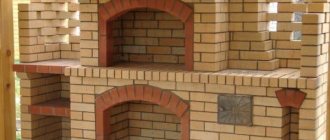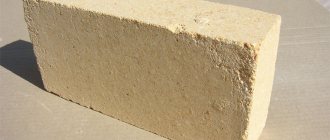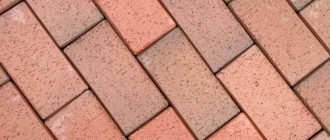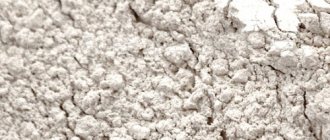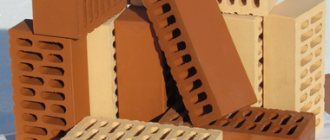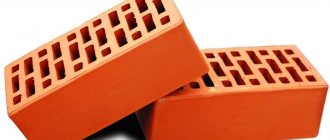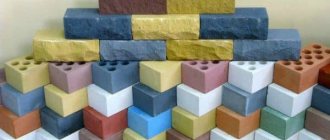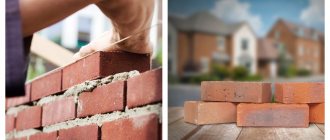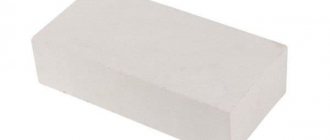Production Features
Red brick can be called a strategic material, therefore the process of its production is strictly regulated by national standards. Today they focus on GOST 7484-78 and GOST 530-95. According to regulatory documents, clay with a minimum content of marl and sulfates is used as raw material . Mining is carried out by open-pit mining, and brick factories are mainly located near the deposits. As a rule, clay has a reddish tint, so the finished material is called red brick, although its official name is ceramic brick. During the production process, colored pigments can be added to the mass, and then the finished brick will not have the usual terracotta color. The shade of the product strongly depends on the characteristics of the raw material, therefore bricks of different colors are obtained from clay obtained in different deposits.
The clay mass is formed on belt presses, and the uniformity of the composition and the absence of voids is achieved through the use of vibration stands. This is followed by drying and firing. Raw bricks are dried using a chamber or tunnel method . The first option involves drying the workpieces in a room where the temperature and humidity parameters change in the required sequence. The tunnel drying method involves passing trolleys with raw materials through zones with different microclimates. The result is almost the same.
The mass is fired in furnaces at temperatures of 950-10500C until the part of the glassy phase in the product reaches 8-10%. It is with these parameters that brick acquires the best strength indicators. Properly fired brick gives a ringing sound when struck and has a red-brown tint. If it is not burned enough, the color will be closer to mustard, and the sound upon impact will be dull. Burnt brick can be recognized by its melted edges and dark core.
The properties of the finished brick also depend on which formation method was chosen:
- The plastic formation method involves making bricks from a clay mass with a moisture content of 15-30%. The product is obtained by extrusion. Vacuum units are used to produce hollow samples. The blanks are dried in a chamber and fired in kilns or tunnels. This brick is more frost-resistant and is recommended for building a house;
- dry and semi-dry forming method . In this case, a clay mass with a lower moisture content is used (about 7-12%, it all depends on the characteristics of a particular production), raw brick is made from it by pressing under pressure up to 15 MPa. Drying is absent altogether or is present in a reduced version. The final stage is firing. In terms of performance, such bricks are slightly inferior to plastic-molded bricks, but have a more precise geometry. Ceramic facing bricks are usually produced in this way.
Ceramic brick is used when laying foundations, in private construction during the construction of load-bearing walls and partitions, outbuildings and garages. The facing type of brick is widely used in the decoration of facades, and is also sometimes used for interior decoration.
Basic composition
The brick contains clay and modifying additives. The clay binder component is characterized by plasticity in working condition, making it easy to form a building block of a specific shape. Another advantage of the base raw material is the ability to maintain physical parameters after drying and gain high strength after additional firing.
Tunnel kiln for firing brick products Source yamkz.ru
Clay raw materials
Technical characteristics of clay may vary depending on the depth of the source material. The plastic mass initially contains 4 main components: illite, kaolinite, montmorillonite and sand. They set the basic properties, based on which the choice of material is made (what this or that brick is made of):
- Astringent properties . The indicator is measured as a percentage relative to the mass of sand contained in the test mixture. Operating limits are 20-80%. The higher the value, the better the binding ability of a particular clay.
- Shrinkage . This refers to the sedimentation ability of the material during drying (air) and firing (fire). As moisture leaves the composition, to one degree or another, the given shape changes downward. The normal rate is considered to be 6-8%.
- Plasticity or fat content . Here there are 5 options based on the degree of resistance of the working mass to maintaining a given shape after pressing. Highly plastic ones do not collapse, low-plasticity ones delaminate.
Red brick made of medium-plastic clay Source cdvor.ru
See also: Catalog of construction companies that have their own production of materials and components for the construction of houses
- Caking ability . This property of the material is transformed into ceramic stone under the influence of high temperature. Based on these values, three types of clay are distinguished: low temperature (up to 1100 degrees Celsius), medium temperature (1100-1300 degrees) and high temperature (more than 1300 degrees).
- Fire resistance . One of the main criteria for choosing the final product is the preservation of quality and technical characteristics when heated.
Compared to its analogues, kaolin clay is considered the most refractory; it does not melt at temperatures above 1580 degrees Celsius. As a rule, it is used for the production of porcelain products. A mass that is resistant to influences of 1350-1580 degrees is considered refractory. It is used to make sewer channels and facing clay bricks with a small addition of functional additives.
Heterogeneous compositions are classified as low-melting. This clay is used to produce building materials for masonry work and roofing tiles. Here, applicability is determined by the chemical composition and fraction of solids contained in a particular feedstock.
Crushed natural clay Source yandex.net
Functional additives
Various components are added to the feedstock before molding block products. Their action is aimed at improving certain characteristics that are important for a specific final product. The table provides a brief description of the main additives that are used in the production of bricks.
| Material | Action | Result |
| Sand, ash, slag. | Weakening | Shrinkage is reduced and the process of forming blanks is simplified. |
| Wood shavings and sawdust, powdered coal and peat. | Burnouts | They reduce the specific gravity of raw materials and give the mass a porous structure. |
| Iron ore, sandstone | Toning | The molding process is simplified and the color of the final product changes. For example, red bricks must contain compounds with iron. |
Advantages and disadvantages of ceramic bricks
The raw materials that are used to make red brick, and the production technology itself, allow us to talk about the many advantages of this material :
- environmental friendliness . The composition includes practically only clay, and this is a natural raw material;
- aesthetics and variety . There is a wide range of red bricks on the market in various sizes, shapes and shades. The facing brick can have a relief surface, so that any idea can be realized;
- excellent heat and sound insulation qualities ;
- high level of resistance to negative atmospheric (sun rays, frost, moisture, temperature changes) and biological factors (fungus);
- durability;
- fire resistance;
- relatively affordable price.
significant disadvantages , except that it is heavy, so you will have to take care of creating a solid foundation, but it is worth it. Sometimes builders complain about the insufficient durability of the material or inaccurate geometry, but all this is due to violations in production technology. To buy high-quality bricks, it is better to buy them from trusted and reputable manufacturers and sellers. Residents of the Central Federal District can recommend the products of Kashira Brick Plant LLC, located in the village of Ozherelye, Moscow Region. Kashira brick is produced using raw materials from its own deposits, which allows us to monitor quality at all stages and offer customers the lowest prices.
Brick production
Pallet form for two raw bricks.
People began making bricks from clay several thousand years ago, and this building material is still popular, only now it is made not by artisanal methods, but in industrial conditions.
Making bricks is a lengthy process. Drying and firing in production are not constant processes. Exposure time and temperature vary depending on the composition of the feedstock and additives used. To do this, a brick production plant employs a technologist who studies raw materials and selects optimal production parameters.
Industrial production
The quality of the product directly depends on the quality of the clay, and therefore red ceramic bricks produced in different factories differ in characteristics. 2 manufacturing methods are used:
Material and tools for making bricks.
- No drying. The prepared raw materials are mixed well and red brick is formed using semi-dry pressing, which is then fired in special kilns, where the temperature reaches 1000-1050°C. After this, the fired brick is transferred to a warehouse for sale.
- With pre-drying. The prepared raw materials are molded, automatically loaded into trolleys and sent first for drying and then to a brick kiln. Drying occurs in chamber or tunnel dryers. In the first case, trolleys loaded with raw bricks are rolled into a chamber, inside which the humidity and temperature gradually change, depending on the technology. In the second case, the trolleys are rolled into a tunnel, moving inside which they move from one temperature zone to another. This method is suitable for continuous production, because only with a continuous supply of raw material can the conditions inside the tunnel be well maintained.
The method of firing ceramic bricks allows for the production of products of various shades of red.
Normal firing gives the product a red color, and weak firing gives it a light pink color. The harder the brick was baked, the richer and darker the color should be and the better the properties of the brick.
Do-it-yourself production
Diagram of the kiln and laying of raw bricks for firing with wood.
Making bricks at home does not at all mean making them in an apartment, because this is pointless: in a residential area it is unlikely that you will be able to create conditions for making bricks with your own hands. But a dacha or a utility yard in a private house is quite suitable for these purposes. This is done, of course, in the warm season, so that the resulting products can be properly air-dried.
Of course, homemade building materials will not have the same qualities as industrially manufactured and fired bricks, but if there is a need to build a structure in the yard, you can save significant money by making your own building materials. Making bricks from clay that can be dug up and brought in will save part of the budget. You can make stone and concrete bricks at home.
Equipment for the production of bricks is a container for mixing clay dough, molds for preparing products and a kiln for firing. The first thing to do is to check the clay for “professional suitability”. Experts who know how to make bricks with their own hands advise soaking some raw materials in a bucket or trough and leaving them for 3 days, covering them with polyethylene. This will increase the plasticity of the mass.
Scheme of a multi-furnace kiln and shrinkage of raw bricks for firing with coal.
High-quality brick production requires good preparation of raw materials, so aged clay is checked for suitability for molding and drying. The clay dough should not stick to your hands or metal. To check the quality of the mixture, roll a “sausage” as thick as a finger and screw it onto the bottle. If the process was completed without cracks or breaks in the mass, the mixture is suitable for use, otherwise peat chips, sawdust, and bran from grain crops must be added to it. Pieces of additives should not exceed 5 mm in size, and their volume should not be more than 1/5 of the volume of clay.
In order for clay bricks to be of good quality, the clay should not be very greasy. The simplest test: make a cake from clay dough with the diameter of a medium orange (about 10 cm) and a ball the size of a small chicken egg (about 4-5 cm in diameter). After drying for 3 days in the shade, you need to check whether cracks have appeared on the surface of the products, which will indicate excessive fat content of the clay. In this case, you need to add sand to it, but not more than 5% of the total volume of clay.
Name of the sides of the brick.
If there are no cracks, this does not necessarily mean that everything is fine. Excessively thin clay does not crack, but it produces too fragile products. The second test will help here. You need to “drop” the dried ball from a meter height. If he remains unharmed, then everything is fine. Otherwise, you need to select and add fatty clay. You should carry out several test batches, selecting the proportions of raw materials, and only after that start making bricks at home:
- First you need to briquet the products, for which you will have to prepare special forms. The mold for the brick must be smooth from the inside, for one or several products, collapsible or non-dismountable. At this stage, it should be taken into account that the product will shrink during drying, so the raw brick along all edges should be 1 cm larger than the finished product. For example, for a single brick, the raw material should be made 26x13x7.5 cm in size.
- You need to dry the product slowly and evenly to prevent it from warping. The air temperature must be at least 10°C. Wooden panels or a layer of dry sand are laid on the ground, and a canopy is placed on top to protect against precipitation. Drying can also be done in a barn. Depending on the temperature and humidity of the air, the process takes 1-3 weeks and is considered complete if there is no wet dark spot inside the raw material broken in half.
- Firing is carried out in a homemade stove, for which firewood is also suitable, but coal is more effective, which requires approximately 1 ton per 10 thousand pieces. raw Firing lasts up to 4 days with a gradual increase in temperature to at least 850°C, and cooling lasts about 2 days. If there is very little material, then a brick kiln can be replaced by an ordinary metal barrel of the appropriate size, under which a fire is laid.
A high-quality red brick rings when struck with a hammer, and when broken it has a uniform structure and the same color. Even after spending several hours in water, it retains this uniformity of structure and color.
Ordinary and facing brick
Depending on the area of use, ceramic bricks are divided into two types:
- private, also known as construction worker or ordinary;
- front, or facing, or facade.
Building bricks are used to create foundations, construct load-bearing walls and partitions. Small chips are allowed on it, but the geometry of the samples must be accurate. After the construction of the wall and partitions, ordinary brick requires cladding. The material is usually made solid, but hollow samples - they are used to create non-load-bearing partitions. In size it can be single, one and a half, double, etc., we’ll talk about this separately.
Face brick is more interesting in terms of variety. It is used to decorate the facade and can be used in interior decoration. As a rule, these are hollow bricks that weigh less and have improved thermal insulation properties. The facing brick must have precise geometry and uniform color. As for the shade, the natural color of ceramic bricks is quite beautiful and noble, so you don’t even have to look in the direction of tinted samples. If you want something original and extravagant, then you can find colored brick . Coloring is carried out in mass by adding pigment, so that the original shade will remain for a long time.
Facing bricks differ not only in color, but also in surface type. In the simplest version, it will be perfectly smooth, perhaps with chamfers . This is a traditional and proven option. If you wish, you can move away from the classics and choose one of the following surface types :
- embossed. A three-dimensional pattern is formed on the required end of the unfired brick using a stencil. After processing in the oven, the pattern remains, but the strength of the brick does not change at all;
- engobed. Engobe, a layer of ceramics mixed with metal oxides, which are responsible for creating a certain shade, is applied to the dried but not yet fired brick. In the oven, under the influence of high temperatures, the engobe is fused with the clay mass of the brick. The result is a complete, durable product with an interesting shade. Engobe is sometimes applied only to part of the end, forming a spectacular transition of colors;
- glazed. If you apply glaze instead of engobe, you can end up with a brick with a smooth, shiny surface, which not only has excellent aesthetic qualities, but also additionally protects the material from moisture.
Facing bricks are produced not only in the standard parallelepiped shape - there is a wide range of shaped bricks . It can have rounded corners, cutouts and waves; there are wedge-shaped, trapezoidal and many other patterns, the shape of which is difficult to describe. These elements are necessary for the effective design of window and door openings, corners and ceilings of the house.
Dimensions and weight of bricks
The main regulatory document is GOST 530-2012. This document describes the weight ranges of bricks based on their size and density. In total, there are 7 classes of bricks for solid and hollow blocks. Also, the most common sizes of red brick are:
- Single – 250×120×65 mm;
- One and a half - 250x120x88;
- Double - 250x120x103 mm.
Facing bricks can be classic (250×120×65) and European (250×85×65).
On one pallet fits:
- 300-350 pieces of facing bricks;
- 420 pieces of solid single brick;
- 380-400 pieces of one and a half.
The weight of red solid brick is 3.2-3.6 kg depending on density, hollow brick - about 2.5 kg, single facing brick weighs 1.45-2.2 kg depending on size. Please note that sand-lime brick is the heaviest structural material, its weight ranges from 3.7 to 4.2 kg for a solid block; facing brick can weigh 3.5-3.95 kg.
The size of the brick is the main factor affecting the strength of structures made from it. The more precise the geometry of the blocks, the more uniform the stress in the walls, columns, arches, and supports, the more weight the structure can withstand. In our online store you can buy red bricks with different grades of strength, from M-100 to M-150. Our specialists will help you choose the appropriate size for your needs, prepare a free estimate of the cost of building materials, and complete your order with other materials (cement, dry building mixtures, aerated concrete blocks).
Hollow and solid brick
The performance qualities of a brick largely depend on the type of its internal structure. Ceramic bricks can be solid or hollow. Solid , as the name implies, does not contain voids and is characterized by a minimal number of pores. Due to this, excellent strength and frost resistance are achieved. Solid brick is necessary to create foundations and load-bearing walls. The absence of pores and holes leads to high thermal conductivity, so solid ceramic bricks must be insulated. As a rule, solid bricks are made of ordinary bricks, but solid facing products are also found.
To reduce weight, save raw materials and increase thermal insulation qualities, holes are made in the mass. They can be round, rectangular or slot-shaped, located vertically or horizontally, be end-to-end or closed on one side. The proportion of such holes in ceramic bricks sometimes reaches 45%.
Hollow brick is used for laying partitions, less often - when creating lightweight external walls. The exception is brick with horizontal voids; it cannot be used when laying load-bearing walls due to its low mechanical strength - under weight it can simply deform and break. Typically, facing bricks are made in a hollow design.
Separately, we note porous brick , in which, in addition to holes, there are also pores. They are obtained by adding a charge to the clay mixture and burning the latter during processing in a kiln. Quite large pores remain in the mass, which become the key to improved thermal insulation qualities. Porous brick is large in size, walls can be built from it very quickly, and in terms of thermal conductivity the material is almost close to foam concrete, wood and gas silicate. This brick has special channels into which vertical reinforcement is poured. This technology makes it possible to build warm houses in seismically hazardous areas.
A parameter such as density . For solid brick it reaches 1600-1900 kg/m3, and for facing brick it is approximately 1300-1450 kg/m3.
Solid and hollow
Both ordinary and facing types of bricks can be made either in the form of solid ceramic bars without voids, or with voids (cracks) inside. Monolithic products are usually called solid, and those with voids are called hollow or slotted.
- The former are used where special strength is needed (when laying a foundation, building load-bearing walls). The latter, due to the voids inside, retain heat better, so it makes sense to lay external walls from them. Also, slotted facing bricks can be used for cladding facades.
Figured (the second name is shaped) ceramic bricks can have rounded or beveled edges, curved edges. Decoratively decorated, often made to order.
They are used to make ornaments, decorate facades, design arches and window openings, and make decorative elements.
The following video will tell you how to choose a brick for construction:
Did you like the article? Share with friends on social networks:
And subscribe to site updates in Contact, Odnoklassniki, Facebook, Google Plus or Twitter.
Ceramic products are among the most ancient. After all, for their production, an easily accessible material is used - clay.
Red brick, also classified as a ceramic material, has not lost its popularity for many centuries. Due to its low cost and a whole host of useful qualities and properties. We will talk about this further, touching on the technical characteristics, dimensions and properties of ordinary red ceramic bricks.
Each brick is a parallelepiped, the long side of which is 25 centimeters. The thickness of a single brick is 6.5 centimeters, a thickened (or one and a half) brick is 8.8 centimeters, a double brick is 13.8 centimeters.
The standard width of products is 12 centimeters, according to GOST 530-2012. The European standard EN 771-1:2003 provides for Euro bricks a length of 28.8 centimeters and a width of 13.8 centimeters with a normal thickness of 6.5 centimeters. American bricks are thinner: 7.8 centimeters. All other sizes correspond to Russian ones.
As for the specific and volumetric weight of red ceramic bricks, it differs between solid (solid) and hollow products. General requirements, according to the standards, state that one piece of brick should not be heavier than 4.3 kilograms. On average, products with voids weigh 2.5 kilograms, and solid representatives of red ceramic brick (1 piece) - from 3.4 to 3.8 kilograms.
The average density of ordinary solid, hollow and other types of ceramic red brick is discussed below.
This video will tell you in detail about the dimensions of red brick:
This characteristic (measured in kilograms per cubic meter) makes it possible to find out how much one cubic meter of material weighs. The more porous the brick, the lower this figure. And the lower the thermal conductivity of structures built of brick. So all these parameters are interconnected.
By the way, to obtain pores, a so-called “mixture” is added to the clay mass.
This is finely chopped straw, sawdust, coal or peat crumbs. When heated in a thousand-degree oven, the clay sinteres, and these additives burn out, creating voids. In a solid brick, there should be no more than thirteen percent voids.
For convenience, according to density, all ceramic bricks were divided into seven classes, designated by numbers from 0.7 to 2.4. In accordance with the class, products have a certain thermal efficiency (for more details, see the “Energy Efficiency” section).
- If we give specific numerical values, then for solid ceramic bricks the density varies from 1600 to 1900 kilograms per cubic meter. For hollow red ceramic bricks, this density indicator ranges from 100 to 1450 kg per m3.
And now the thermal conductivity coefficient of ceramic red brick will be considered.
Brick size
In construction, it is customary to focus on the dimensions of a standard (single) brick. This is a parallelepiped-shaped block with dimensions of 250*120*65 mm. A huge part of ordinary and facing bricks are produced in this format. In addition, bricks of other sizes can be found on sale:
- one-and-a-half brick , 250*120*88 mm, allows you to significantly save time when laying massive structures;
- double brick , 250*120*138 mm, usually made hollow and used in lightweight masonry;
- narrow brick , 250*60*65 mm, is the format of the facing material;
- thin brick, 250*22*65 mm, approaches the tile format and is used only for cladding.
There are other less common brick formats, as well as sizes produced only by a certain manufacturer. For example, a Euro has a thickness of 0.7 of the standard, modular - 1.3 of the standard
The size of the brick is regulated by the domestic GOST 530-2007 and the European standard EN 771-1:2003. The same documents regulate possible deviations from the norm : in length - 4 mm, in width - 3 mm, in height - 2 mm. When purchasing, you can check several bricks for geometry accuracy. If the manufacturer did not cheat, then the laying can be done as quickly and simply as possible.
Raw materials used
Basic shapes and sizes of bricks.
The raw material for the production of ceramic bricks is clay - a rock that becomes plastic when moistened, and after drying at high temperatures hardens to the state of stone. Its main composition is minerals, and its most famous property is water resistance: it is clay soil that absorbs water the worst after rain.
Clay has been known since ancient times as a material for the production of pottery. Another industry where it is actively used is the production of bricks. However, the quality of raw materials varies greatly from deposit to deposit; not everyone is suitable for using clay in its pure form. Therefore, with the start of production, you need to adapt to each deposit, you need to experiment with the material and the drying process.
Basic properties of ceramic bricks
Ceramic brick is evaluated according to a number of characteristics:
- strength grade shows how much load in kg can withstand 1 cm2 of brick. If this indicator is 100 kg/cm2, then this is the M100 brand, if 150 kg/cm2 - M150, etc. Bricks of grades M75-M100 are used for the construction of partitions and walls in low-rise buildings. For the foundations of country houses it is better to use M150 brick, and for the construction of the foundations of apartment buildings, M200-M300 brick is suitable;
- thermal conductivity depends on the number of pores and cracks in the brick. Solid brick has low thermal insulation properties and is only suitable for the construction of load-bearing walls. Hollow ordinary brick can be used in the construction of low houses; it allows you to make the thickness of the walls much smaller;
- The moisture absorption of ceramic bricks is low, which in particular is the reason for its widespread use in construction. Solid brick has a moisture absorption level of 6-14%. However, when room temperature drops to street level, moisture can penetrate into the pores of the material and crystallize, which will gradually reduce the strength of the structure;
- the vapor permeability of ceramic bricks is about 0.14-0.17 Mg/(m*h*Pa), which is enough to create a normal microclimate in the room and remove excess moisture from it;
- frost resistance expressed in freeze/thaw cycles. For the construction of load-bearing walls, it is better to take a brick with frost resistance F50, and if the construction will be carried out in difficult climate conditions, then F75-F. If facing bricks are used for wall decoration, then it must also have high frost resistance. Angobe and clinker bricks show themselves best in this regard;
- The fire resistance of ceramic bricks is the highest among other building materials. It resists direct fire for more than 5 hours. For comparison, the same indicator for reinforced concrete is 2 hours, and for metal structures – generally 30 minutes. Ceramic ordinary brick can withstand a maximum temperature of 14000C, and clinker brick can withstand temperatures of 16000C;
- soundproofing . Brick dampens noise quite well. A brick wall with two bricks (530 mm thick) can block 60 dB of noise, and one brick - 50 dB.
Properties and characteristics of red ceramic bricks
Dimensions and weight
- Each brick is a parallelepiped, the long side of which is 25 centimeters. The thickness of a single brick is 6.5 centimeters, a thickened (or one-and-a-half) brick is 8.8 centimeters, a double brick is 13.8 centimeters. The standard width of products is 12 centimeters, according to GOST 530-2012.
- The European standard EN 771-1:2003 provides for Euro bricks with a length of 28.8 centimeters and a width of 13.8 centimeters with a normal thickness of 6.5 centimeters. American bricks are thinner: 7.8 centimeters. All other sizes correspond to Russian ones.
As for the specific and volumetric weight of red ceramic bricks, it differs between solid (solid) and hollow products. General requirements, according to the standards, state that one piece of brick should not be heavier than 4.3 kilograms. On average, products with voids weigh 2.5 kilograms, and solid representatives of red ceramic brick (1 piece) - from 3.4 to 3.8 kilograms.
The average density of ordinary solid, hollow and other types of ceramic red brick is discussed below.
This video will tell you in detail about the dimensions of red brick:
Density
This characteristic (measured in kilograms per cubic meter) makes it possible to find out how much one cubic meter of material weighs. The more porous the brick, the lower this figure. And the lower the thermal conductivity of structures built of brick. So all these parameters are interconnected.
By the way, to obtain pores, a so-called “mixture” is added to the clay mass. This is finely chopped straw, sawdust, coal or peat crumbs. When heated in a thousand-degree oven, the clay sinteres, and these additives burn out, creating voids. In a solid brick, there should be no more than thirteen percent voids.
For convenience, according to density, all ceramic bricks were divided into seven classes, designated by numbers from 0.7 to 2.4. In accordance with the class, products have a certain thermal efficiency (for more details, see the “Energy Efficiency” section).
- If we give specific numerical values, then for solid ceramic bricks the density varies from 1600 to 1900 kilograms per cubic meter.
- For hollow red ceramic bricks, this density indicator ranges from 100 to 1450 kg per m3.
And now the thermal conductivity coefficient of ceramic red brick will be considered.
Thermal conductivity and thermal insulation qualities
The thermal conductivity coefficient is usually called a parameter that shows how much thermal energy is required to change (increase) the temperature by one degree Celsius in a room with meter-long brick walls.
Therefore, when designing buildings, this coefficient must be taken into account when calculating how thick the outer walls should be made. If they are less than a meter, then they must be insulated.
The value of the thermal conductivity coefficient for solid products ranges from 0.6 to 0.7. For hollow ones - from 0.25 to 0.5. Units of measurement are Watt per meter per degree Celsius. The smaller this parameter, the better the thermal insulation ability of the finished structures. Accordingly, hollow brick is the leader in this regard. However, load-bearing walls and other parts that carry heavy loads cannot be constructed from it. Therefore, they are certainly insulated.
This video will tell you about the thermal conductivity of ceramic bricks:
Energy efficiency
Now let's talk again about the density classes of ceramic bricks. Each of them corresponds to a certain efficiency (in terms of heat saving):
- Classes 2.0 and 2.4 have low efficiency.
- Products of class 1.4 are usually called conditionally effective.
- Bricks of class 1.2 are considered effective.
- Class 1.0 includes products with increased efficiency.
- Classes 0.7 and 0.8 are highly efficient.
Environmental friendliness
Ceramic bricks contain only natural ingredients that are safe for humans and animals. Even its red color is due not to the introduction of an artificial coloring pigment, but to a shade of clay. Therefore, the environmental friendliness of ceramic red brick is one hundred percent.
Unlike many synthetic building materials, brick is not capable of causing allergies or poor health. After all, it does not emit toxic substances during operation and is quite suitable for the construction and finishing of medical, children's, educational institutions, and catering establishments.
Soundproofing ability
Quite an important characteristic - after all, no one wants to listen to noise coming from the street through external walls. For ceramic bricks, which absorb sound waves well, this parameter is determined by SNiP 03/23/2003. Naturally, brick cannot compare with cork or wood, but compared to concrete, it muffles noise much better.
Thus, a wall with a thickness of half a brick (15 centimeters) can pick up up to 47 decibels. A wall with one brick (28 centimeters) will dampen 54 decibels, and a wall with two bricks (53 centimeters) will dampen 60 decibels. In addition, hollow products have better sound insulation abilities than solid ones.
Fire resistance limit
In this parameter, ceramic brick is also at its best. It is superior in fire resistance not only to wood (which is quite natural), but also to concrete and metal. So:
- A brick structure can resist fire for at least five hours.
- Concrete or reinforced concrete structures can withstand fire for two hours.
- Metal structures succumb to flames after half an hour.
Life time
According to this characteristic, ceramic brick is comparable to concrete. Buildings built from it can stand without collapsing, not even tens, but not one hundred years. In any case, they are guaranteed a reserve of two hundred years. Naturally, provided that high-quality material is used.
Special types of ceramic bricks
Other types of bricks can be made from clay using a similar technology. Some features in the composition and nuances of the manufacturing process make it possible to create a material with slightly different properties. Special types of ceramic bricks include:
- fireclay refractory brick made from fireclay clay, the peculiarity of which is the presence of refractory substances. Firing occurs at high temperatures, so the material ultimately withstands up to 17000C and is used for laying stoves and chimneys;
- clinker brick They are made on the basis of shale clays, which, like fireclay, are refractory. In firing furnaces, the temperature reaches 11000C, individual particles are sintered, and the voids are filled, so we can talk about the special strength and fire-resistant properties of the material. The strength grade reaches M400. Clinker bricks are excellent for paving paths, cladding facades, and arranging stoves and chimneys.
What is red brick?
The product is an artificial stone of regular shape, which is obtained from mineral raw materials (clay with components) that are fired at high temperatures. You can get it in two ways:
- drying and subsequent high-temperature firing;
- semi-dry pressing.
Old red brick has the same qualities as new brick. Both options are used everywhere in construction:
- For the construction of foundations, basements, for the construction of partitions, load-bearing and external walls.
- Facade cladding and interior finishing.
- Special (fireproof) red fireclay brick is used for the construction of fireplaces and stoves, and the construction of special-purpose buildings.
Red brick characteristics
Like any other material, it is endowed with certain characteristics. These include the following points:
- Durability
. Indicates the maximum permissible load per 1 cm². A fundamental indicator that is important in any construction, since brick must resist loads and deformations and at the same time not succumb to destruction. Strength is indicated by the letter “M”, next to it is a number indicating the degree of strength. The indicator for red brick can vary from 25 to 300 units. - Frost resistance
. Represents the ability of a brick to absorb moisture. Porous has less, and dense has high resistance to frost. This indicator is about and subsequent numbers indicating the number of defrosting and freezing cycles that the product is able to endure. Modern brick can withstand 50 to 100 times. - Filling
. Bricks are divided into solid and hollow. The former have no holes, while the latter occupy more than 50% of the area. Hollow ones have low thermal conductivity, only with proper laying. - Dimensions
. The most common indicator for a single one is 25x12x6.5 cm. Additionally, they produce one-and-a-half 25x12x8.8 cm and double 25x12x13.8 cm. The size of the latest types of red bricks has advantages over single ones in terms of saving mortar and time spent on construction.
How are red bricks made?
This building material is produced from clay using various additives that improve its characteristics. The process of making red brick consists of the following steps:
- Clay mining
. It is carried out using heavy equipment - a bulldozer or excavator. After removing the top layers of soil, the remains are transported to the place of further processing. At this stage, coarse grinding occurs. - Preparation of raw materials
. Extraneous large inclusions are removed. The bricks are then dried, crushed and sifted. To improve sintering, it is mandatory to add burnable raw materials: sawdust, peat and crushed coal, as well as non-plastic compounds: coarse sand, slag and fireclay. - Forming and drying products
. After thorough mixing, the mass enters the molding press and into the drying chamber. Drying takes place with a gradual rise in temperature and no air movement. This ensures uniform evaporation of moisture and obtains a smooth and even surface. - Firing
. The most critical stage. The kiln consists of three zones: preparation for heating, firing at an average temperature of 1000°C and cooling. A red brick fireplace can only be built when the clay and other components have been fired at a temperature of 1300°C.
What is the difference between red brick and white brick?
When making a choice, you need to know what differences are present in different types of these building materials. Let's consider which brick is better, white or red, having become familiar with their similarities and differences. What the two materials have in common includes:
- Made from natural raw materials.
- Can be used in different climates.
- The result is reliable and beautiful buildings.
- Unpretentiousness, because they successfully resist the influence of external factors.
The differences between these building materials are as follows:
- Raw materials for production
. The red one is made from clay, and the white one is made from sand and lime. - Preparation method
. Brown is dried and fired, and light is produced by exposure to steam under high pressure. Clay bricks can be made at home, but lime bricks require special equipment.
Advantages and disadvantages of red brick
Functional advantages of ceramic bricks
is:
- reliability and long service life of created objects;
- low moisture absorption;
- versatility and ease of installation;
- aesthetic appearance;
- environmental friendliness and safety of the material;
- vapor permeability;
- resistance to temperature changes.
Solid brick retains heat indoors worse than hollow brick . To eliminate this drawback, builders install thermal insulation on the walls, and the solid block is replaced with a hollow one. But replacement can only be done when constructing low-rise buildings that do not regularly experience high loads. Partitions with a load-bearing frame can also be filled with hollow bricks.
House lined with red brick.
In modern construction, the benefits of using a certain material are important. This quality is typical for the hollow version, because for the manufacture of a building block with the number of voids about 13% of the total volume. As a result, clay consumption and the cost of construction work are reduced. You should know that a hollow block with horizontal pores will be less durable compared to a material where the pores are placed vertically.
Compared to sand-lime brick, the ordinary type has a higher cost. To avoid efflorescence, a high-quality solution should be used during the laying process. To purchase single-color bricks, you should purchase them in batches.
Comparison of white and red bricks
Despite the similar name, white brick has a different composition, which includes quartz sand and limestone. During the production process, the material is not fired, but pressed and processed in an autoclave.
Features of sand-lime brick are:
- good heat retention (compared to red hollow brick);
- strength, uniformity and density (depending on the brand). Sand-lime brick is more difficult to break than ceramic brick;
- low cost;
- good sound insulation ability.
Despite its many disadvantages, sand-lime brick has disadvantages . The material is susceptible to moisture and will deteriorate when soaked for a long time. Therefore, it is not suitable for creating foundations . Sand-lime brick is mainly used to create partitions and interior walls. Red ceramics have no such disadvantage.
The second disadvantage of white brick is its instability to high temperatures . When heated strongly, it begins to collapse, filling the air with harmful substances formed when released. Therefore, silicate material is not suitable for the construction of fireplaces and stoves.
Thus, each material has certain properties that determine the variability of its application. These must be reviewed before construction and taken into account during the planning stage.
When purchasing brick blocks you should pay attention
for the following details:
- uniform color over the entire surface, mostly red. A surface painted with pink spots indicates insufficient firing of the product, and a brown color indicates excessive firing and a violation of technology;
- you need to choose the right shape of blocks. As a result of technology violations, the reliability of structures may decrease, the level may not be maintained, or the cost of the solution may increase;
- choose hollow and solid blocks depending on the required properties. A solid monolith is more resistant to impact loads and durable, while hollow versions have a lighter weight and excellent adhesion to the cement composition.
- Due to its high fragility, ceramic bricks should be transported carefully, and when purchasing it is necessary to set aside a certain percentage for “breakage”.
Red brick in warehouse.
